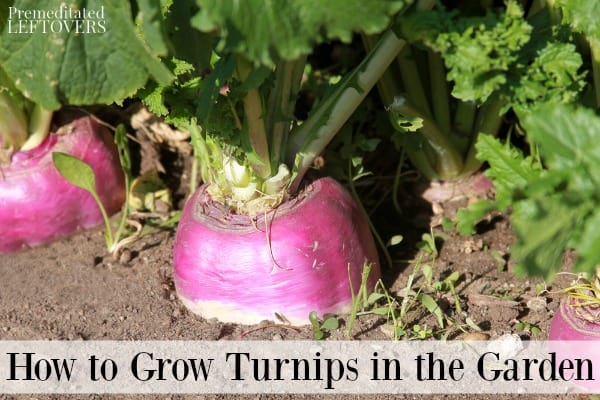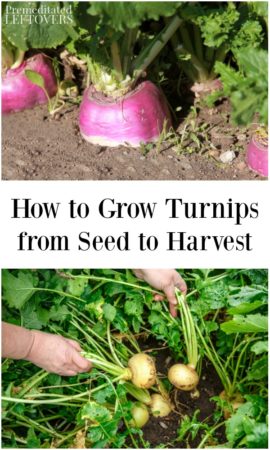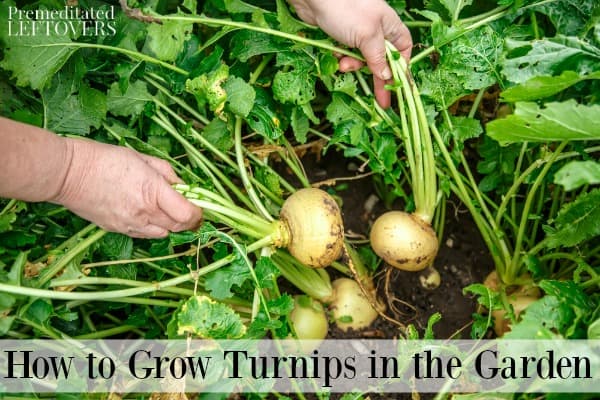These tips on how to grow turnips will help you care for you turnips from seed to harvest.

Turnips are making a comeback as gardeners realize how easy and inexpensive they are to grow, and just how tasty they can be! Turnips are ideal for cooler growing conditions, so if you live in an area with a short growing season turnips may be for you. Fun to grow and fun to eat, turnips take up little space as well, making them ideal for small gardens. Look below at some helpful tips on how to grow turnips and see why you should put them on your summer growing list.
How to Grow Turnips
Planting turnips will be done from seeds, as chances are you won’t find seedlings in any gardening centers. Don’t worry though, because turnips grow quickly so planting from seed is ideal even if you have a short growing season.
How to plant turnip seeds
To plant your turnip seeds, choose an area that gets full to moderate sun. Turnips will do just fine with partial shade, so don’t worry if your garden isn’t especially sunny. There is no need to get fancy with turnip seeds. Just rake some loose and fertile soil and sprinkle the seeds right in. There is no need to make rows of any kind or even dig holes. Cover the seeds loosely with soil and sprinkle with water. Don’t be afraid to pack the seeds in (since you will be thinning them out later) and put an entire packet in just the space of a foot or two. Now the waiting begins! Continue watering until your seedlings arrive.
How to plant turnips in pots
If you are limited on garden space you can plant turnips in pots or even window boxes. Make sure they have a good 6 inches to grow into and plants are spaced a few inches apart. Turnips will even do well in raised garden beds and can be planted right beside radishes, carrots, or other root vegetables. If you wish, turnips can even be planted alongside flowers in your garden beds.
How to care for turnip plants
After just a few weeks, you will notice turnip seedlings sprouting up. Now is the time to thin out any weak or underperforming seedlings. This way the stronger ones will continue to get nourished and grow. At this time you can feed the turnips with a slow release fertilizer. Continue watering with an inch or so of water per week.
At this time, you can plant additional turnip seeds so that your garden is producing well into the winter months. Since turnips do well in chilly climates, you can plan on growing all the way until October in some areas. Spacing out your plantings will ensure growth all through the seasons.
You won’t notice too many issues with pests in turnips, but if you do notice anything eating the foliage just use a basic dish soap and water mix to spray them away. If you do use a store bought solution make sure it is food safe.
How to harvest turnips
In about 45 days your turnips will be ready to pull. It is smart to pull one turnip and see if it is done before pulling a bunch. While turnip sizes will vary, most will be about the size of a golf ball and range in colors from white to purple.
You should know that turnip foliage/greens are also edible. If you allow the turnip to stay underground too long and it gets bitter, leave the plant in the soil to harvest the greens as needed. They can be used in soups and salads. If you wish, you can even cut the turnip from the stem and place the stem back in the soil. It may continue to regrow.
Once harvested you can use those turnips just like most root vegetables. Eat them fresh, in salads, in soups, in stir-fry, or you can even can them for later use. For a small investment, you can produce an abundance, making them well worth your efforts.
Give these tips for growing turnips a try and see what a budget-friendly food item they can be to grow.



Leave a Reply